Editor’s Note October 2017: While Sightline senior researcher Dan Bertolet wrote his recent article on Seattle’s new proposal to reduce excess parking, he came across this popular post from four years ago. This photo-essay highlights how parking minimums create seas of underutilized paved space (and ugly architecture).
When you build a new house or shop, you must provide a minimum number of off-street parking spaces.
Cars have shaped much of the North American West, including Cascadia, where drive-through restaurants, shopping centers, highway strip malls, and single-family neighborhoods miles from commercial services dominate much of the urban and suburban landscape. Less obvious to the casual observer is the impact that parking regulations have had on architectural forms.
Cities have established parking regulations, often called off-street parking minimums, for each possible land use. When you build a new house or shop, or often when you simply remodel a building or change its use, you must provide a minimum number of off-street parking spaces. These regulations are meant to address demand for parking that cannot be met by nearby on-street spaces, but they have also led to increased development costs, less flexibility for adaptive reuse of existing buildings, and some pretty unattractive architecture.
This photo essay looks at some of the ugly architecture in Cascadia that has resulted from parking minimums. Many of the photos were sent in by readers who responded to our request for examples from their communities.
One obvious example is the ubiquitous seas of suburban parking. The commercial building pictured below is set so far back from the street, behind its legally required parking, that it’s hard to figure out what type of business operates there.
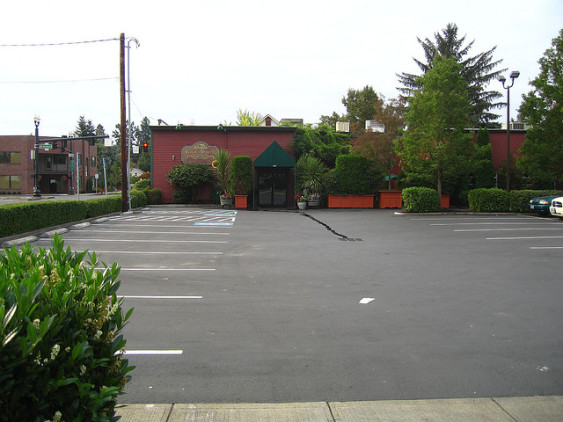
Photo sent by Derek Severson.
In Western Oregon, a mixed-use developed community called Fairview Village (below) has a Target store as its retail anchor. Although the development has won awards for livability and smart planning, this sea of required parking looks pretty standard.
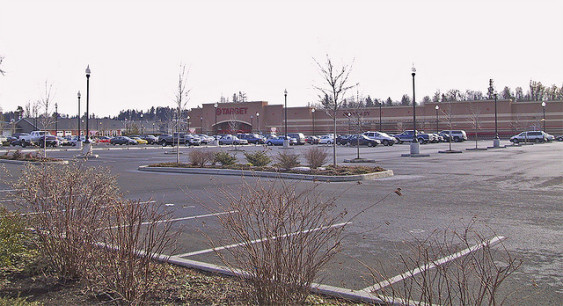
Photo by Flickr user Brett VA.
The main entrance of this office building in McMinnville, Oregon, is barely visible from the sidewalk.
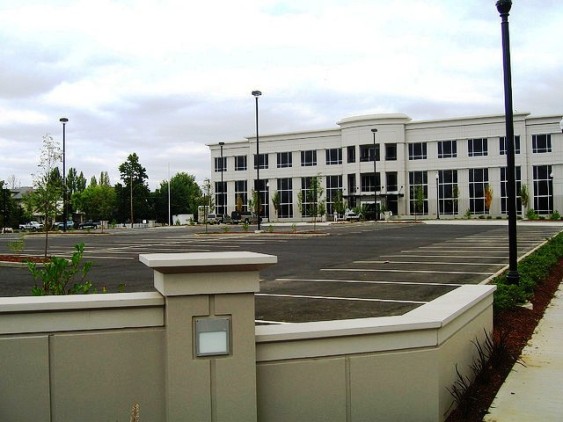
Photo sent by Derek Severson.
Offering a glimmer of hope in an oversized suburban parking lot, a Taco Time in Edmonds, Washington, has reclaimed a couple of parking stalls by creating an outdoor seating area for customers.
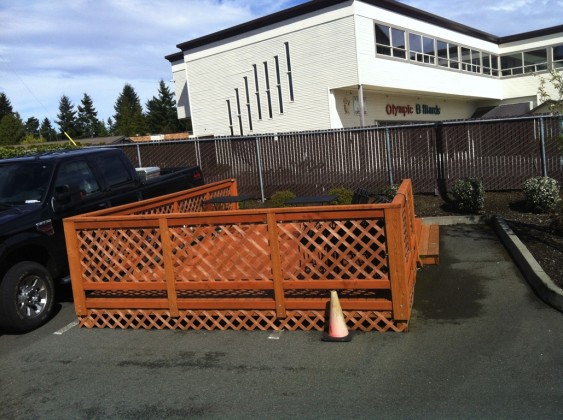
Photo sent by Brice Maryman.
Ugly parking areas are not unique to the suburbs, however. There are many urban examples as well.
Before parking minimums, buildings in Cascadia could be built to the property line because parking wasn’t a constraint. Now, developers must contend with building heights, setbacks for buildings, and parking regulations—all of which make it harder to develop affordable housing projects. This is especially true at medium densities and lower building heights because it’s harder to make parking garages or underground parking pencil for these smaller projects. This is easy to see by taking a quick look at a single street in Seattle’s Ballard neighborhood.
This classic apartment building in Ballard was built before parking minimums.
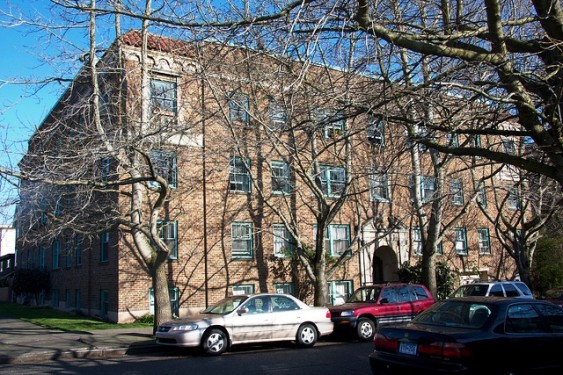
Photo by Jon Stahl, used with permission.
It sits just down the road from a cluster of “dingbat buildings”—apartment complexes supported on stilts with open carports on the ground level.
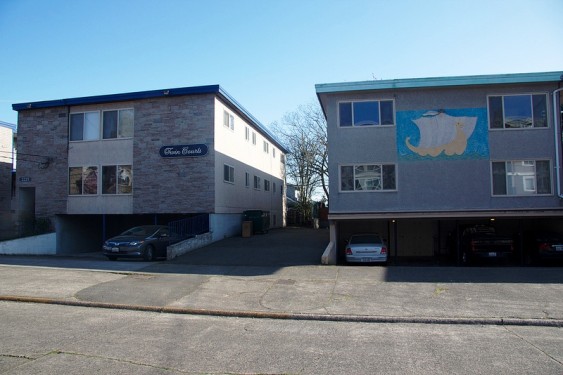
Photo by Jon Stahl.
In his book The High Cost of Free Parking, Donald Shoup describes how dingbat buildings proliferated in Los Angeles as a result of a 1930s zoning regulation requiring each unit of a multifamily dwelling to have one covered parking space.
Dingbat buildings are commonplace in Cascadian cities, too, such as this example in Seattle’s Ballard neighborhood.
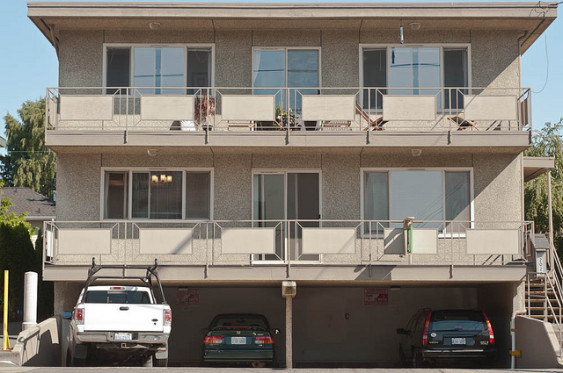
Photo by Holy Outlaw.
And this one, also in Ballard.
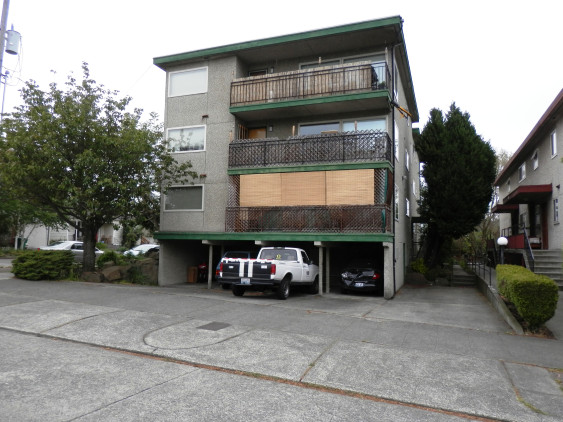
Photo by Alan Durning.
And this one nearby.
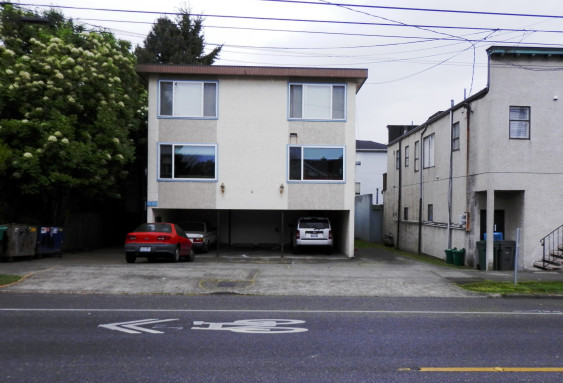
Photo by Alan Durning.
And this dingbat fourplex, in Medford, Oregon.
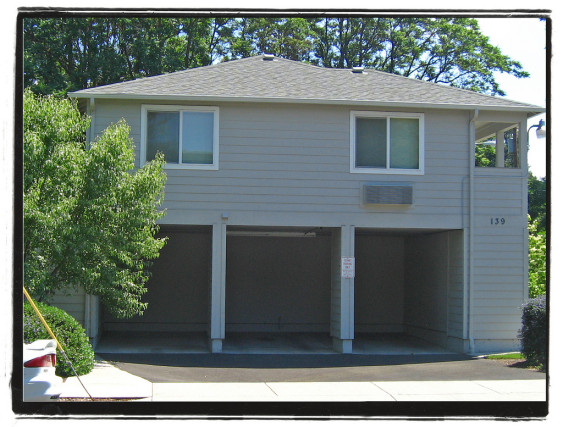
Photo sent by Derek Severson.
These houses in South Seattle have covered garages instead of carports, but the dingbat form is much the same.
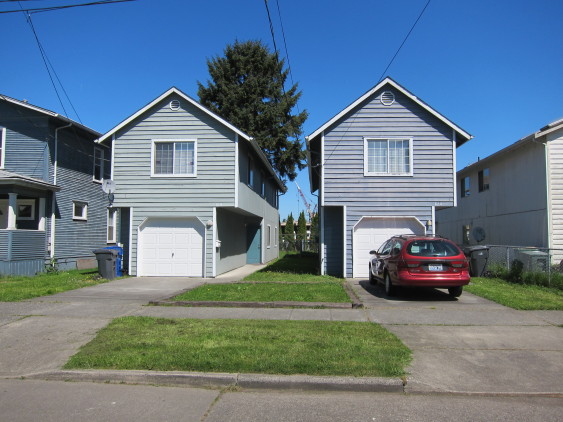
Photo by Alyse Nelson.
Parking regulations have not only given rise to architectural forms such as dingbats, but they have transformed existing types of housing, including the multifamily courtyard building. Courtyard housing was popular for decades before the advent of modern zoning codes. These buildings, such as the one pictured below in Portland, featured lovely green spaces surrounded by a U- or L-shaped structure.
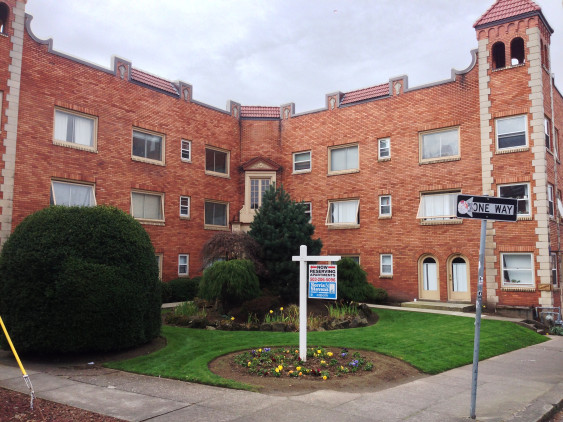
Photo by Rex Burkholder, by permission, from Getting to 2100 blog.
This late-1920s courtyard building in Seattle’s Capitol Hill neighborhood features a landscaped green.
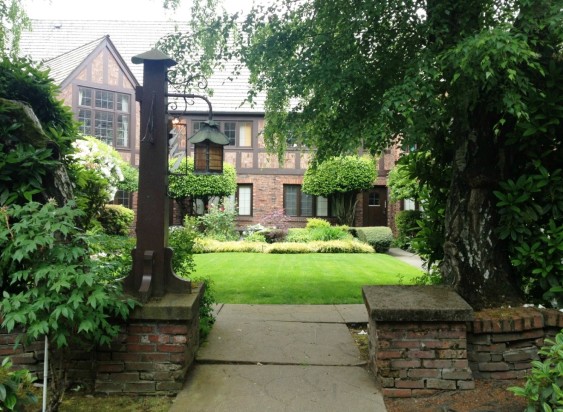
Photo by Meaghan Robbins.
Since the advent of parking minimums, courtyard-style apartments have continued to be built. But instead of landscaped courtyards, the buildings surround a different type of courtyard: a parking court, as illustrated by the Portland parking court below.
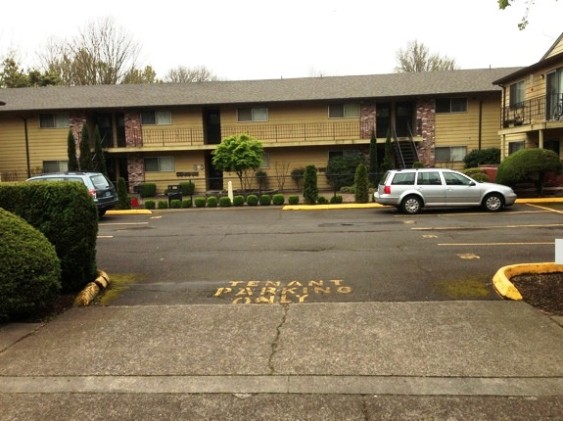
Photo by Rex Burkholder.
And these two parking courts in Seattle.
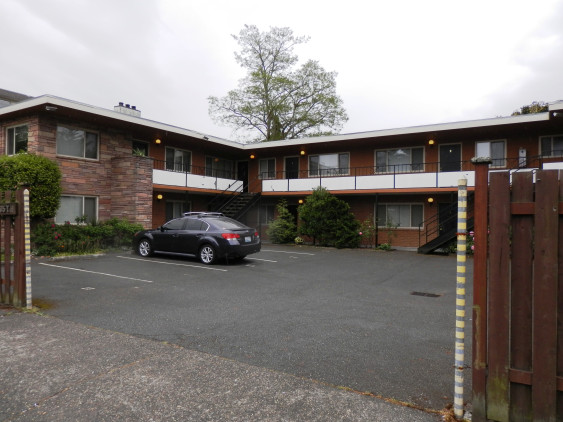
Photo by Alan Durning.
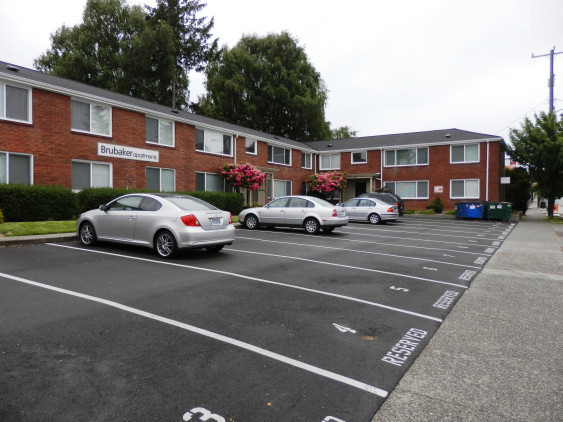
Photo by Alan Durning.
Where there could be a front yard, this motel-style apartment building in Seattle’s Ballard neighborhood has a parking court, too.
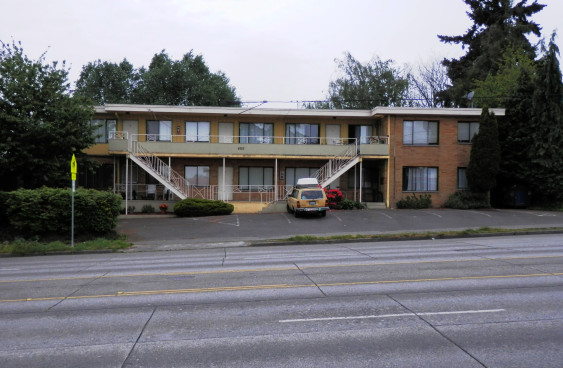
Photo by Alan Durning.
Parking minimums have also partly dictated the look of some of Seattle’s newer townhouses. Unlike more traditional row- or townhouse developments in other cities, which have a welcoming pedestrian entrance off the sidewalk, usually with stairs and a front porch or stoop, like these ones in Brooklyn…
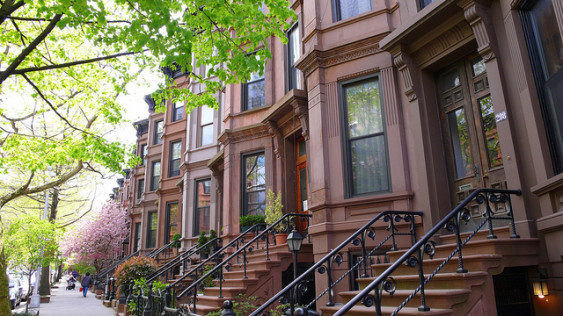
Photo by rutlo.
…many of the new Seattle townhouses, like the two pictured below, feature dark parking courts and tall fences built to the sidewalk edge.
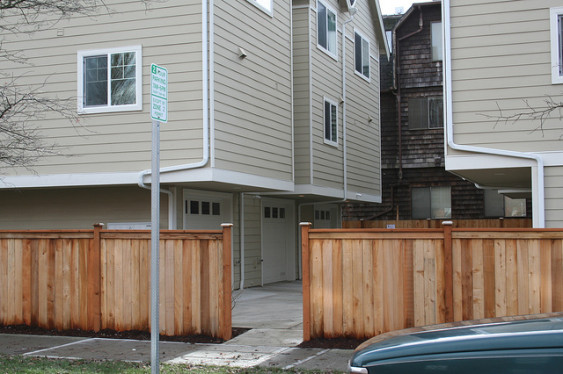
Photo by Flickr user jseattle.
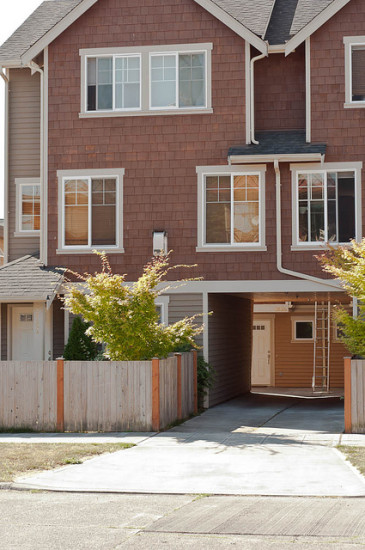
Photo by Flickr user Holy Outlaw.
Blogger Gregory Wharton explored why the structures look like this. He found that strict zoning rules that set maximum building heights and setbacks and require an off-street parking stall for every unit have limited developers to a very specific design. As Seattle architect David Nieman has explained, the Seattle townhouse “is not a building type at all but, rather, a parking diagram that people happen to live above.” The resulting architecture has not been well received by the community, but, Wharton writes, “these projects are exactly what the Seattle zoning code tells developers to build.”
With parking rules essentially mandating their form, Seattle’s townhouses stand out as a perfect example of what’s known in the design community as “design by zoning.” Fortunately, the City of Seattle fixed this problem by removing parking requirements for multifamily housing in urban centers and villages in its recent multifamily zoning code update, no longer effectively mandating such townhouse design.
For instance, to reach their front doors, residents of this Capitol Hill townhouse development must go through the locked driveway gate…
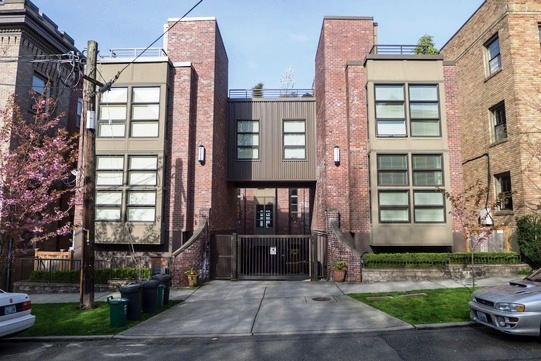
Photo sent by Matthew Amster-Burton. (See Amster-Burton’s new book, Pretty Good Number One.)
…to this concrete garden awaiting them inside.
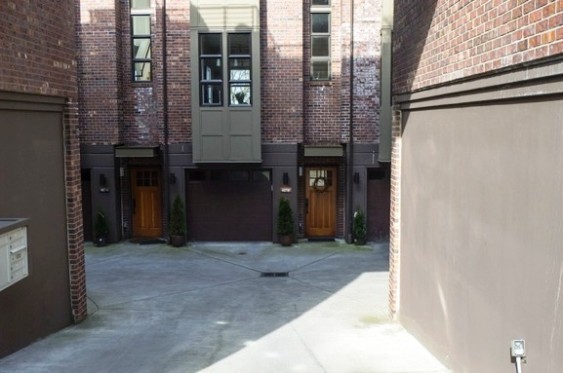
Photo sent by Matthew Amster-Burton.
Consider how those townhouse developments differ from recent cottage housing communities, which have historical roots in the early 1900s bungalow court cottages of Southern California and the garden city movement, which envisioned small towns surrounded by green belts. Cottage neighborhoods are designed around people rather than cars. They have smaller homes that are meant to appeal to one- or two-person households, and the parking area is shared among the residents, requiring people to park and then walk to their homes. Below is one such cottage community in White Salmon, Washington.
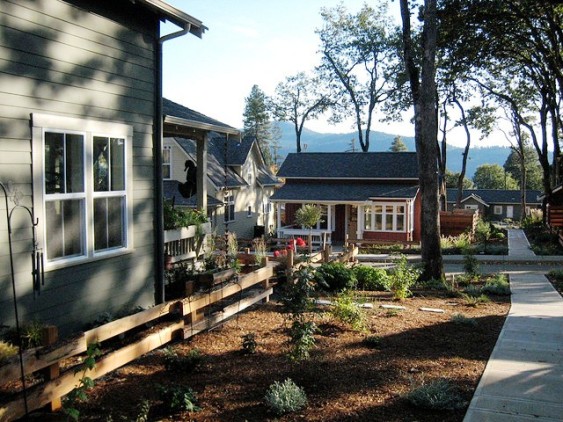
From Flickr user studio-d.
While townhouses are usually developed in multifamily zones, cottage communities are typically built in single-family zoning districts. Cottage developments usually require greater housing density to be successful. These projects also need less parking because the smaller units appeal to small households. Unfortunately, single-family zoning districts don’t always have the flexibility to allow this additional density or to reduce parking requirements. Where these cottage developments have been allowed, it has often been under a flexible zoning or incentive program.
Danielson Grove (below), a cottage housing development in Kirkland, Washington, was built under Kirkland’s Innovative Housing Demonstration Program, which encouraged creative solutions to meet housing demand. Planners in Kirkland ended up adopting many of the standards used in this community in a citywide ordinance.
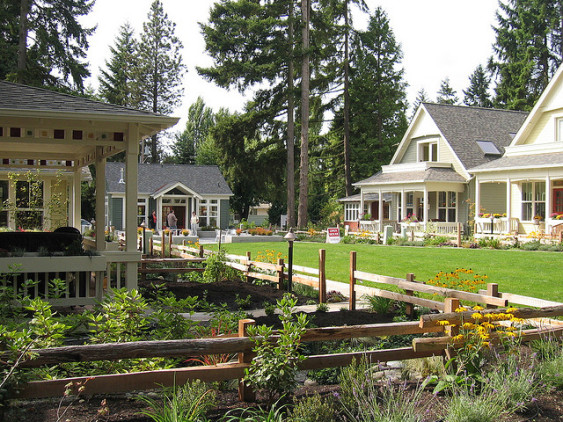
From Flickr user studio-d.
Unfortunately, zoning incentives that allow increased density and reduced parking requirements to encourage such people-oriented neighborhoods aren’t found throughout Cascadia. Off-street parking requirements and car culture have too often resulted in communities dominated and designed around cars. Front porches, if they are built at all, have gotten smaller while garages have grown larger in many cities and towns.
Cities usually require off-street parking spaces for single-family homes, but they don’t specify whether they have to be enclosed. That’s not the case in the Seattle suburb of Beaux Arts Village, where new and renovated homes are required to provide parking for at least two cars in a carport or garage of at least 360 square feet. Reader Matt Leber sent in this photo of his garage, which dominates the single-family lot.
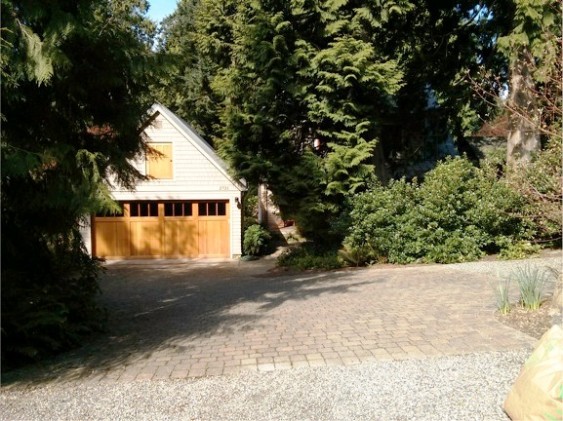
Photo sent by Matt Leber.
In Donald Shoup’s estimation, many neighborhoods “have become garagescapes—appearing to be a place not where people live, but where cars are parked—and the only obvious way to enter a building is with an electronic garage-door opener.”
The following “garagescapes” don’t exactly convey welcome. Garages at the front of these Tigard, Oregon, apartments serve as the primary entrance to the community.
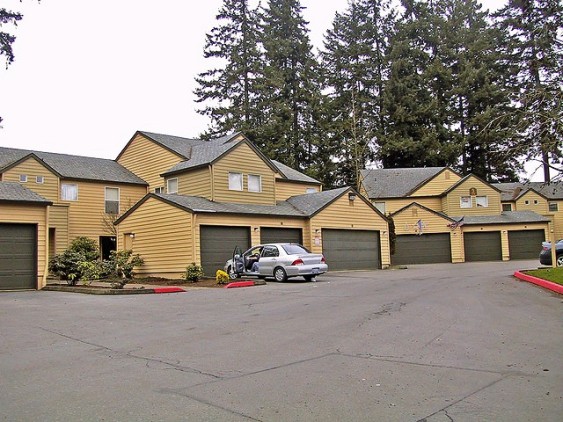
Photo by Flickr user Brett VA.
Rather than front porches, garages dominate the streetscape in the Oregon neighborhood pictured below. The driveway curb cuts also create an undulating sidewalk.
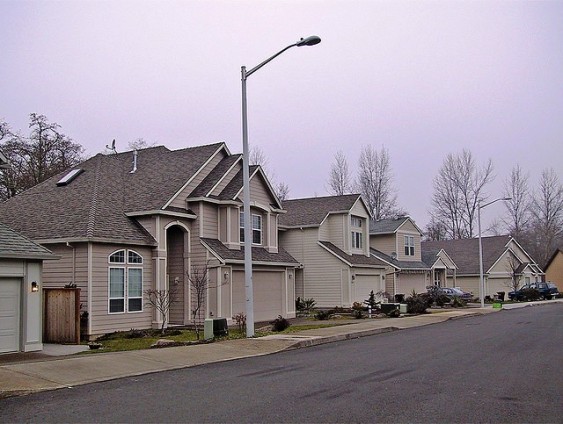
Photo by Brett VA.
This apartment complex along a busy street in Tukwila, Washington, greets cars first.
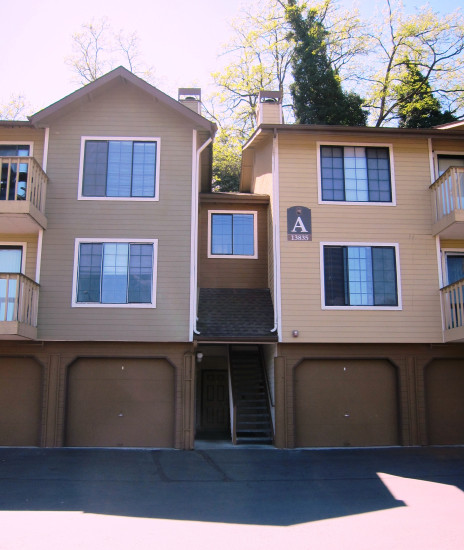
Photo by Alyse Nelson.
As does this Portland garagescape.
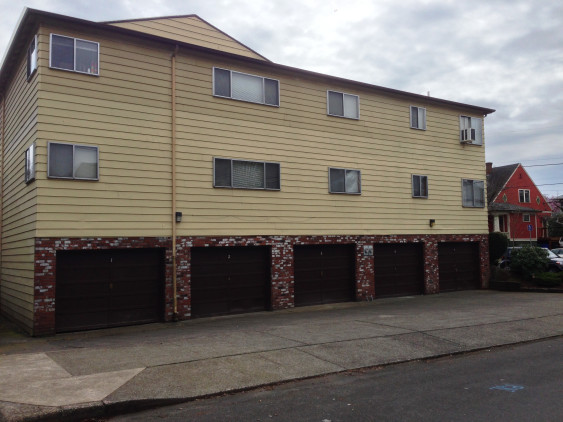
From Getting to 2100 blog.
Garagescapes, dingbat buildings, automobile courtyard apartments, seas of parking—parking minimums have resulted in a variety of ugly architecture in Cascadia’s cities and towns. Zoning codes apply a general parking ratio across the landscape, with little regard for market conditions, transit opportunities, and the demographic makeup of neighborhoods.
As cities work to reduce automobile dependency, provide more affordable housing, and create more people-oriented places, it’s time to address parking regulations. The next time you see an unsightly apartment building or a sea of parking in front of a store, consider how parking rules have contributed to the ugliness. Off-street parking regulations are at the root of what makes Cascadian cities and towns less attractive and livable.
Check out more parking rules that raise your rent.
This article edited by Ina Chang.

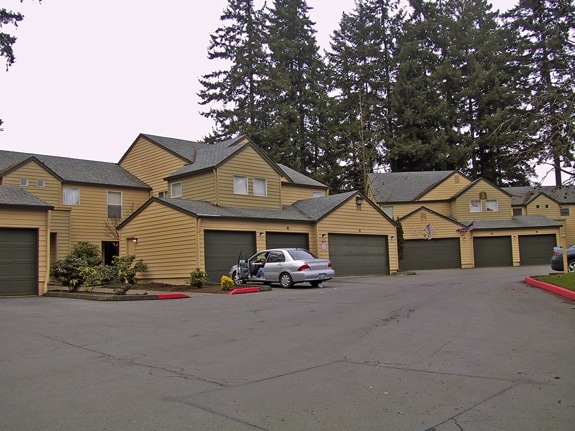
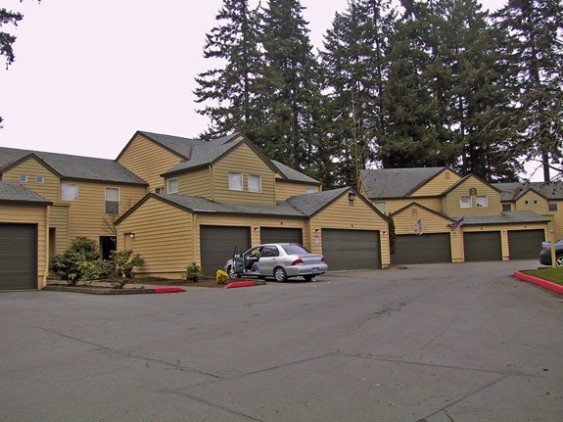









überfahr
Excellent posting with images that drive the point home: home is ugly when we park our driving vehicle nearby — or try to hide it. The impact on our daily life livability has been devastated by not only the sheer dangers posed by cars to people – especially children and the elderly who are slaughtered and maimed by motor vehicles regularly, and the pollutants emitted by such units – but by the negative impact these dangerous, CO2 emitting units have on our daily life quality.
Giving up on our public spaces where communities and societies can exchange ideas and interact on a human level likely has irrevocably negative consequences for its nearby people. I imagine that there are significant scientifically measurable connections between localized violence and human discord (or lack of), and the lack of (or abundance of) habitable public spaces for congregation and human interactions.
Jeb
Good visual preference collection.
You might be interested in this picture from Portland of Reed College’s Elliot Hall with cars parked in front from 1934.
Compare with a more recent image.
Alyse
What a great comparison that shows how removing cars can allow for a people-oriented space. Thanks for sharing!
Alan
And, they had the sense, somewhere twixt then and now, to get all that stupid ivy off the building before it destroyed the brickwork.
benschon
You don’t have to go to Brooklyn to find beautiful townhouses that would be illegal under current zoning rules. Here’s one on NW 17th and Irving in Portland.
Alyse
Very true! What a lovely example. Thanks for sharing.
tyler
too bad they’re directly across the street from that fugly warehouse. beautiful houses though.
Richard Masoner
Show these to Ms Dorothy Rabinowitz so she can see the true meaning of “begrimed.”
Resuna
I’ve lived in places with and without off-street parking, and the “welcoming facade” quickly loses its appeal when faced with the daily grind of finding a damn place to park.
And I don’t even want to own a car.
You can’t fix the problem by changing the building code, you can only fix it by making it possible to live in the community without owning a car. That means drastically redesigning the whole city around public transport. Start now, and your grandchildren might be able to enjoy the results.
Sujit Patwardhan
What a wonderful selection of photographs of pre-and post “car domination” age. Should be seen by our dumb planners.
Lisa Welch
Hey! Those dumb planners were trained to do this by academia. Many planners, however, have seen the light, but now it’s the dumb politicians, banks, developers, etc. that perpetuate it.
Roger P.
It’s not correct to put all the blame on minimum parking requirements in land use codes. Most off-street parking built after WWII is there because developers wanted it, not because code required it.
Perceptions were that tenants and customers demand the parking, and without it projects would fail. Every suburban retail development, the parking is not there because of code minimums, it’s there out of necessity.
Lenders also require a certain amount of parking before they fund a project, because without it they won’t get an adequate return on their investment.
Much of the blame for ugly parking lots can be put on architects. There are ways to do parking well, but there are lots of architects (ones that got C grades in Design classes?) who fail the task. And don’t forget the cheap developers who don’t want to spend money on doing parking right.
The author of this piece oversimplifies. Even without minimum code requirements, most of the ugly parking she points out would still be there.
MIchael
Show don’t tell. Let’s see pictures of parking done right. I’ll believe it when I see it.
Roger P.
First, I’ll concede that to some readers, there is no such thing as parking done right. Parking should be structured or screened from view. Visit Bellevue Way, the block south of NE 8th St. Kemper Freeman has built a walkable streetscape on Bellevue Way, with parking in structures behind the storefronts.
Alai
In response to Roger P.:
As far as I can tell, that walkable streetscape was built by sacrificing most of the rest of the streetscape of the block that development is on. Yes, it’s an improvement over having no streetscape at all, but…
Matt the Engineer
“Most off-street parking built after WWII is there because developers wanted it” I’m sure this is at least partially true, but it’s hard to say how many structures would have been built with less parking without these laws.
But the point stands: why do we still have these laws? Some developers may still build the same parking without them, but some surely will build less parking (and better structures IMHO).
Alyse
Roger P.:
You’re right – many developers will likely want to provide parking with their development either because of market conditions, lenders’ preferences, or the adequacy of transportation alternatives. But in many communities, minimum parking regulations may not be based on the actual conditions of the community or the specifics of a site. That can lead to cities requiring more parking than a developer might otherwise provide based on a market analysis of the specific circumstances at that site. This can raise the cost of development – ultimately resulting in higher rents. As a practicing urban planner, I’d suggest that planners could do more good trying to make sure that parking that is provided is well designed instead of requiring a specific number of spaces based on a generalized parking ratio.
Roger P.
Alyse, thank you for acknowledging that there are other factors involved in parking development, not just minimum code requirements. Urban development is complicated business, and it’s not helpful to call out one factor alone as responsible for all problems on a given topic like off-street parking.
Lee Niner
THANK YOU for pointing this out and documenting it so thoroughly with pictures. You’ve made a point that so many of us are feeling but haven’t expressed so eloquently.
Dat Klopt
Nothing in this article is actually true. The many examples in Oregon are the result of land use policies that permit a landowner to use as much of their property as they wish, for parking. They were built in locations and communities that had no land use regulations at the time. Same for Seattle (which had no comprehensive land use regs until the 1950s). The buildings she describes as ‘dingbat’ architecture, which are not actually dingbat architecture but who cares, were built BEFORE Seattle had land use regulations, long before. Even then, however, Seattle has street use regulations and if they would not have allowed these owners to put in corner to corner curb cuts, the parking would be much different. Keep in mind that for a good three decades (approx 1940 to 1970) Seattle had no functional transit alternative, so people had to drive, even to in-city jobs. The building she so proudly mentions are being built without parking… well, I lived there until two years ago. The ground floor has an underground garage for about 25 cars, which the current owner uses to house his antique car collection. The problem with Sightline, Valdez, Erica, and many others who purport to make land use and design prognostications based on a few weekends in Brooklyn (that picture includes a friend’s building, where I stayed in March!) is that they they have no idea what they are looking at. The beautiful Baroque buildings on Capitol Hill ALL have underground parking underneath those courtyards. Not enough for today’s couples who typically own 2-3 cars (one for him, one for her, one for BM and other excursions, called a ‘trailhead car.’) I wish Sightline would stop writing articles like this. They have no idea what they are talking about. There are many things the city could do to reduce cars, reduce the need for parking, and beautify the community. Sightline and others seem to have no idea what these solutions are.
Roger P.
You make a number of good points, Dat, but I do take exception to your assertion that Seattle had “no functional transit alternative” between 1940 and 1970. Just not true. In 1940 Seattle Transit System was tearing out the last tracks of an old and by then very decrepit streetcar network and replacing it with an expanded electric trolleybus system.
Those electric buses carried 300 million riders a year during WWII. Yes, ridership declined after the war as people began moving to the suburbs, beyond the range of the transit network. Downtown was the single transit hub, and a large percentage of office and retail workers took the bus to work, even after the war.
And BTW, transit ridership continued to decline until Metro took over in January 1973. That’s when the turnaround began here.
Alyse
Most cities have minimum parking regulations and don’t have a “cap,” or a maximum on the number of parking stalls a developer can provide. If the landowner developing a project wants to provide more parking than the regulations require, you correctly state that cities generally won’t stop them. Some cities are starting to address this issue by creating a maximum parking requirement in addition to minimum standards, but this is a relatively recent development.
I did not mean to imply that the Capitol Hill courtyard housing project did not have any parking. The point is that the courtyard housing form is harder to develop without putting parking underground or within a structure, which can raise development costs. That ends up translating into higher rents. Even surface parking comes at an added cost.
Many areas of our cities were built before the advent of parking regulations – although most of the buildings I highlight here were built since the 1960s. Buildings constructed before land use regulations may or may not have parking, but in order for the uses to be changed or additional square footage to be added, many cities will require parking to be provided. This can stymie redevelopment, particularly in areas where land is hard to come by.
This photo essay is not meant to get into potential solutions – that will come in later posts that are a part of this series. It was meant to highlight that regulations play a role in the overall urban form of our city.
Max Mulvihill
I can’t help but comment that NOTHING in your post is actually true. Regulations caused this development and to think otherwise is madness? We build unproductively all over the place where zoning regulations limit the scope or government incentives lure in a certain types of development.
Brian in Seattle
Would it be possible to return to alley’s and making sure that the entrance to the parking is behind the building?
In the suburbs, towns and cities would have to require developers to build on a grid system when building a new housing development rather than the pattern of housing developments built today and build alleys in between the rows of houses much as you find in most of Seattle proper and older parts of small towns.
Ross T.
That’s a goofy idea. Giving a property two vehicle accesses is creating a double-fronting lot, and is immensely wasteful of land. But then, you say, we can put laneway houses in the alleys. Now you’ve come full circle.
The answer for vehicular circulation is to (1) create narrow roads and (2) keep the cars and garages as close as possible to that road. Everything else is care-free private space. You might not see those spaces from the road – you need to be invited – but they are maximized, even with small lot SFDs.
Ross T.
The article is misguided in several ways, and just silly in others. For many low-medium density areas of housing, it is regulations of MAXIMUM density that create surplus land that is easily paved.
Also, there is a bias against the drive-by look of the ‘view’ of driveways and garage doors from the street. The reason they are there is to be as close as possible to the driveable street, to use as little land as possible. It is compact. That’s why in a parking lot, parking stalls are immediately adjacent to the aisles.
Also, if aerial photos were used, you’d see many of these properties with out-front garages having large greenspaces in the back, and greenspace between the homes. Look at an aerial of older subdivisions with driveways up the sideyards all the way to a garage at the back corner of the lot. Looks ok from the street, but a massive intrusion into the ‘courtyard’ of a block.
Karl - Houston
For the record, originally from Cascadia. One thing that is omitted is that most zoning ordinances have recoginzed the need for the proper location and amount of parking, but is unable to break away from the ITE standards for the 500 year parking flood, and create enough incentives for developers to change. The other aspect is the fact that most developers choose to put in more parking than required, because their client determined the value for being 40% underparked is much greater than to have consumers leave their lot with not finding a space.
The real answer for suburban areas that are stuck with an autocentric paradigm is to require additional low impact amenities when developers choose to create parking fields such as shade trees, pervious surface, raised sidewalks, ext. Not all areas are going to get away from the big box development (unless the single person auto is gone), but there is no reason why zoning ordinance can’t transition to create green fields of parking that meet the needs of developers.
I just don’t believe that the zoning ordinance is the only thing to blame, you have to include the ITE as well at least.
Karl - Houston
40% overparked* is a much great asset than to thave 1 too few spaces.
Sorry for the confusion, their coffee isn’t very good down here.
Alyse
Good point about the Institute of Transportation Engineers (ITE) Manuals — this article by Donald Shoup (http://vtpi.org/shoup.pdf) explains that many jurisdictions get their parking ratios for minimum parking requirements from the ITE surveys. According to Shoup’s article, ITE surveys are generally based on peak parking occupancies at suburban sites, which may not be relevant to more urban jurisdictions.
Skye
I enjoyed seeing all the pictures with this piece. I actually don’t think “dingbat” carport buildings are ugly – there were a number of them on my street in Wallingford and I always thought they looked cool and retro. Garage-based dingbats, however, including a sea of them in Allentown in Tukwila, feel much more closed-off to the neighborhood. Beauty in the eye of the beholder?
There is a glimmer of hope: parking decisions (whether by jurisdictions, financiers or developers) now can be better informed by data: http://www.rightsizeparking.org/
Alicia Cohen
Thank you so much for this incredibly important piece. Cars have destroyed so much of the pleasure and beauty of our lived environment but their crimes against joy and aesthetics are almost entirely ignored. You are doing the work of making cars and their true costs to quality of life visible–thank you.
Callie
The rent (if they’re even available for rent rather than only for sale) on the more appealing designs — like the cottages in White Salmon and Kirkland — or the older landscaped courtyard buildings is usually (if not always) much higher than the dingbat and paved “courtyard” apt buildings. Not only that, but making them prettier by hiding the parking just raises the housing cost one way or another (either by putting them in the suburbs or by increasing development costs).
Marlene Meyer
I love all your concern for visual living. It does make it nicer when cars and garages are not the first thing you see. However, people want convenience first, it seems. There is also one scary aspect about cars underneath lots that none of you have mentioned. It has nothing to do with vision. A car engine could explode, leaving a nice flame going upward.
We need to think more out of the box. If there is a lot away from the living area, then you could provide an electric shuttle to the home. A person with groceries could use that vehicle then return it and walk home. More health, prettier front lot. However, Americans are too personalized and adverse to change.
Marlene
Chris Bongorno
Thanks for the great photo-essay. Here in Cleveland, we have a variety of developers successfully executing center or rear auto courts and traditional “stoop” scapes along the sidewalk, with just one curb cut for a development of, say, 20 units in an urban infill setting. In one case, we just developed a 59-unit townhome community with two curb cuts (one on a main street and one on an old alley) and alternating auto and pedestrian courts between rows of buildings. However, many developers are still putting the garages up front, leading to continuous blocks of curb cuts, little-to-no space for tree lawns or frontage gardens, and the proliferation of cars straddling sidewalks between garage doors and the street. So, some progress, but still too much of the site planning around cars approach!
Tom Lane
I strongly agree with you about the aesthetics, however, with higher density under the smart growth paradigm (see my link), there is less driveway space … resulting in cars clogging the streets, i.e. Issaquah Highlands … where it’s dangerous to bike or skateboard with all the parked cars. The only solution is to discourage street parking with no overnight parking signs, or, banning parking for vehicles over 6 feet tall, or, no parking of vehicles over 72 hours.
Dan Allison
Why specifically do you feel that it is unsafe to have on-street parking? In my experience on-street parking creates friction for motor vehicles and slows traffic, and speed is the greatest single determinant of safety for bicyclists and pedestrians.
mike
thanks for pointing out an ugly, ubiquitous part of the car culture. but if you it’s ugly in the northwest, come down to mexico, where there is no awareness at all of the consequences. iron gates, barred windows, high walls and fences, make the visual assault worse and worse.
with these visuals, no wonder no one wants to leave the ‘security’ of there fortress-like homes
Matt
What do you think of the renovation of garages to patios, as discussed in this article from the Detroit Free Press? Is this a potential outlet for the issue?
http://www.freep.com/apps/pbcs.dll/article?AID=2013307020018
Alyse Nelson
That’s an interesting read – it’ll be interesting to see if the end up changing the ordinance. It reminds me of Alan’s first post in this series: http://www.sightline.org/2013/06/05/whats-in-your-garage/. Many people do not actually park their cars in their garage.
JustInSeattle
Nice article Alan. I liked having the carport when I lived in a “dingbat” building, but the building only had 2 carport spots so at least the curb cut was relatively narrow… I can’t stand the 4+ wide curb cuts like your examples in Ballard, especially with multiple buildings along the block. Feels dangerous and inhospitable, unsafe for kids, and bleak without any street plantings. Of course there are also the vast curbless areas of the city (e.g. north of 85th, south of ??) where the ROW becomes one giant long driveway/parking strip.
I think these cottages near S 30th and Bayview look a lot nicer than typical townhouses here in Seattle, although they obviously still take a lot of land (probably more in this case) for parking than the townhomes. Would be nice if they could do this without the off-street parking, or at least fewer than 1:1. Here’s another interesting old courtyard condo building in upper Fremont in Seattle, although this one has its own circular drive as well as a central green, plus garages fronting street at one end of the block.
Joy Hughes
Dingbat buildings pose another risk too – look at these ones from the ’89 San Francisco quake
Luke McGuff
Thank you for using my photos (Holyoutlaw). The “dingbat” apartment building is one of several in a row on one block in Ballard, they were all built in the 1960s. The cumulative effect is of solid pavement, not a single tree on the street in that stretch. I don’t know if this kind of design is still legal, but even if it is, when these apartments are re-developed, this design will be grandfathered in.
Here is my original blog post that uses these photos, from August 2011: http://www.natureintrudes.net/2011/08/26/layers-of-development/
Jacob Allderdice
It’s worth mentioning that the contemporary work that comes out looking the best in this article (two images that I caught) is the work of the architect Ross Chapin. Credit where credit’s due! http://www.cottagecompany.com/Communities/Danielson-Grove.aspx and http://smartdevelopment.com/
Vivvi
Unfortunately, as long as people continue to own more and more cars, and insist on driving them EVERYWHERE, no matter how short the route, there will be a need for ugly carparks resulting in ugly buildings. People have brought this on themselves by not being satisfied with smaller, and fewer, cars. There are rich neighborhoods in my town where some of the garages are frighteningly huge, and almost as tall as the rest of the house, to accommodate the extra cars and gigantic gas-hogs that these wealthy show-offs insist on owning for no good reason. And when those vehicles are in use, they have to be parked somewhere. A growing population, coupled with a demand for multiple vehicles in every family, is what is driving this non-stop parking lot construction.
In the future, I hope that all new public constructions–whether single buildings or shopping centers–are required to place most or all of the parking lot underground, where we won’t have to look at it; or else construct a multilevel parking garage instead of an unsightly, sprawling asphalt landscape.
pink zebra print invitations
I’ve been a union member at my current job for going on 10 years now and I hate All it does is protect the lazy and fuck over the guys that do ~$100 a month of my paycheck goes to the union for "protection" that i have never needed and will never need because I come to work and do my Meanwhile, jackass A never comes to work and when he does he fucks There is an investigation, union always finds a small technicality and gets jackass A off the I pay ~$100 a month to keep useless people And before someone points out that I can drop the union, no, I Union membership is a condition of